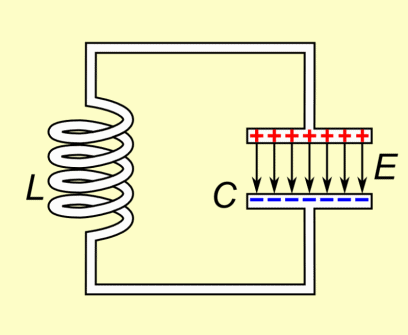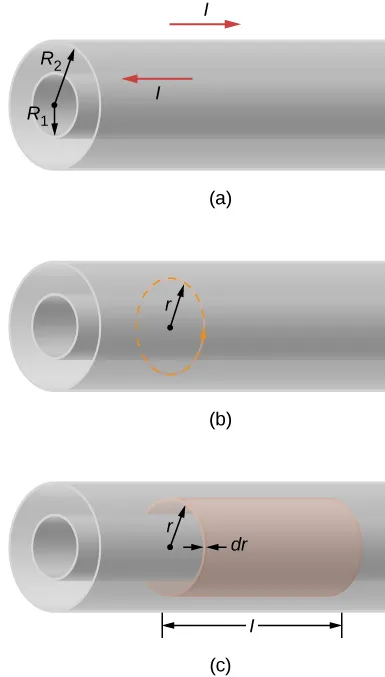
Image source: https://brilliant.org/wiki/energy-of-a-magnetic-field/
Introduction
Hello it's a me again Drifter Programming! Today we continue with Electromagnetism to get into Magnetic Energy Density. So, without further do, let's get straight into it!
Energy stored in a magnetic field (or inductor)
When conductors carry current, a magnetic field surrounding them is being produced. Having the current change with time we cause an electromagnetic induction, which causes the creation of a electromotive force (emf), that is a voltage that opposes the change in magnetic flux (Lenz's law) that was created by the change of current (magnetic flux is proportional to the current). As we already saw in the previous posts there is one "main" type of induction, which is the so called Mutual Induction between two conductors. One of them is the causes a mutual induction on the other and sometimes the "other" conductor may even be itself (self-induction).
The creation of such a opposing voltage (emf) must have some origin (it cannot be created from nothing). Due to energy convervation, some energy needs to drive the original current. This energy can be thought as some form of potential energy that would be imparted on charged particles moving through a region with a magnetic field present.
By definition, the magnetic energy (potenial energy) stored inside of an inductor is equal to:

Where:
- E or U is the magnetic/potential energy stored in a inductor
- L the inductance of the inductor
- I the current flowing through it
Let's now consider a solenoid with length l, N number of turns, cross-section area A and current I that of course works as an inductor. Let's replace the inductance L with the corresponding equation we talked about last time. That way we end up with the following equation for the magnetic energy stored in a solenoid:

Magnetic Energy Density
From the previous equation we get that the energy density, which is calculated as energy/volume is given by the equation:

where:
- B is the magnetic field strength
- μ mostly the constant μ0 (permeability of free space)
For a electromagnetic wave which has a electric / magnetic field ratio c (speed of light) we can also write the electric field's energy density as:

where:
- ε is mostly the vacuum pemittivity constant ε0 = 1 / μ0c^2 (as we know from previously)
- E the electric field magnitude/strength
We can clearly see that both the electric and magnetic fields transport energy, when talking about electromagnetic waves!
Coaxial Cable Inductance Example
Consider two concentric cylindrical shell of radius R1 and R2 respectivelly. Let's determine the magnetic energy stored per unit of length and also the self-inductance per unit of length of cable.

Image source: https://phys.libretexts.org/.../
Using Ampere's law the calculation of the magnetic field both inside and outside of the coaxial cable is very easy! Based on this magnetic field B we can then calculate the energy density of the magnetic field, which now will needs to be an integral over the entire volume of the cylindrical shell. After that the self-inductance per unit length is very easy to calculate! So, let's start!
Using the dashed circular path of figure (b) and because of cylindrical symmtery, considering that B is constant along the path we have:

No current is flowing outside of the cable and so B = 0 for any circular path with r > R2 (outside of both cylinders) or r < R1 (inside of the "inside" cylinder). Therefore, all the magnetic energy of the cable must be stored in between of the two conductors.
The energy density of the magnetic field is:

which is stored in a cylindrical shell of inner radius r and outer radius r +dr, and with a length l as shown in figure (c).
By integrating the energy density for this region we get:

Dividing the result with l we get the energy per unit length which is:

From the simple equation of U we calculate the self-inductance per unit length as:

Note that the indutance per unit length only depends on the inner and outer radius of the cable. This means that we can increase it by increasing R2 or decreasing R1, which can also be done by "changing" these cables. Again a physical/geometrical constant...in some way
REFERENCES:
- https://courses.lumenlearning.com/boundless-physics/chapter/magnetic-fields-and-maxwell-revisited/
- https://brilliant.org/wiki/energy-of-a-magnetic-field/
- https://phys.libretexts.org/TextBooks_and_TextMaps/University_Physics/Book%3A_University_Physics_(OpenStax)/Map%3A_University_Physics_II_-_Thermodynamics%2C_Electricity%2C_and_Magnetism_(OpenStax)/14%3A_Inductance/14.3%3A_Energy_in_a_Magnetic_Field
- http://hyperphysics.phy-astr.gsu.edu/hbase/electric/engfie.html
Mathematical equations that I had in this post where drawn using quicklatex!
Previous posts about Electromagnetism
Electric fields:
Getting into Electromagnetism -> electromagnetim, electric charge, conductors, insulators, quantization
Coulomb's law with examples -> Coulomb's law, superposition principle, Coulomb constant, how to solve problems, examples
Electric fields and field lines -> Electric fields, Solving problems around Electric fields and field lines
Electric dipoles -> Electric dipole, torque, potential and field
Electric charge and field Exercises -> examples in electric charges and fields
Electric flux:
Electric flux and Gauss's law -> Electric flux, Gauss's law
Applications of Gauss's law (part 1) -> applying Gauss's law, Gauss applications
Applications of Gauss's law (part 2) -> more Gauss applications
Electric flux exercises -> examples in electric flux and Gauss's law
Electric potential:
Electric potential energy -> explanation of work-energy, electric potential energy
Calculating electric potentials -> more stuff about potential energy, potential, calculating potentials
Equipotential surfaces and potential gradient -> Equipotential surface, potential gradient
Millikan's Oil Drop Experiment -> Millikan's experiment, electronvolt
Cathode ray tubes explained using electric potential -> cathode ray tube explanation
Electric potential exercises (part 1) -> applications of potential
Electric potential exercises (part 2) -> applications of potential gradient, advanced examples
Capacitance:
Capacitors (Condensers) and Capacitance -> Capacitors, capacitance, calculating capacitance
How to solve problems around Capacitors -> combination, solving problems, simple example
Electric field energy and density -> Electric field energy, energy density
Dielectric materials -> Dielectrics, dielectric constant, permittivity and strength, how to solve problems
Electric capacitance exercises -> examples in capacitance, energy density and dielectrics
Current, resistance and EMF:
Electric current -> Electric current, current density
Electrical resistivity and conductivity -> Electrical resistivity, conductivity, thermal coefficient of resistivity, hyperconductivity
Electric resistance -> Resistance, temperature, resistors
Electromotive Force (EMF) and Internal resistance -> Electromotive force, internal resistance
Power and Wattage of Electronic Circuits -> Power in general, power/wattage of electronic circuits
Electric current, resistance and emf exercises -> exampes in all those topics
Direct current (DC) circuits:
Resistor Combinations -> Resistor combinations, how to solve problems
Kirchhoff's laws with applications -> Kirchhoff's laws, how to solve problems, applications
Electrical measuring instruments -> what are they?, types list, getting into some of them, an application
Electronic circuits with resistors and capacitors (R-C) -> R-C Circuit, charging, time constant, discharging, how to apply
RC circuit exercises -> examples in Kirchhoff, charging, discharging capacitor with/without internal resistance
Magnetic field and forces:
Magnetic fields -> Magnetism, Magnetic field
Magnetic field lines and Gauss's law of Magnetism -> magnetic field lines, mono- and dipoles, Flux, Gauss's law of magnetism
The motion of charged particles inside of a magnetic field -> straight-line, spiral and helical particle motion
Applications of charged particle motion -> CERN, Cyclotrons, Synchrotrons, Cavity Magetron, Mass Spectrometry and Magnetic lens
Magnetic force applied on Current-Carrying Conductors -> magnetic force on current-carrying conductors/wires, proofs
Magnetic force and torque applied on current loops (circuits) -> magnetic force on current loops, magnetic moment and torque
Explaining the Physics behind Electromotors -> tesla, history and explaining the physics behind them
Magnetic field exercises -> examples in magnetic force, magnetic flux, particle motion and forces/torque on current-carrying conductors
Magnetic field sources:
Magnetic field of a moving charged particle -> moving charge, magnetic field, force between parallel charged particles
Magnetic field of current-carrying conductors -> magnetic field of current, Biot-Savart law
Force between parallel conductors and the magnetic field of a current loop-> force between parallel conductors, magnetic field of current loop
Ampere's law and Applications -> Ampere's law, applications
Magnetic materials -> Magnetic materials, classification and types, material examples
Displacement current -> Displacement current, Extension of Ampere's law
Exercises in Magnetic field sources -> examples all around magnetic field sources
Electromagnetic Induction:
Electromagnetic Induction and Faraday's law -> Electromagnetic Induction, Experiments, Faraday's law
Motional Electromotive Force (Emf) -> Motional Emf, Faraday's law and motional emf, generalization
Lenz's law and Induced Electric fields -> Lenz's law, Induced Electric Fields
Eddy Currents and Applications -> Εddy currents, applications (brakes, testing, others)
Maxwell's equations -> What they are, each equation analyzed separately
Electromagnetic Induction exercises -> examples all around Electromagnetic Induction
Mutual and Self Induction:
Mutual Inductance -> Mutual Inductance, applications
Self Induction -> Self Induction, Lenz's law, Inductance of a Coil
And this is actually it for today's post and I hope that you enjoyed it! Next time in Physics we will get into R-L (resistor-inductor) circuits.
Bye!
